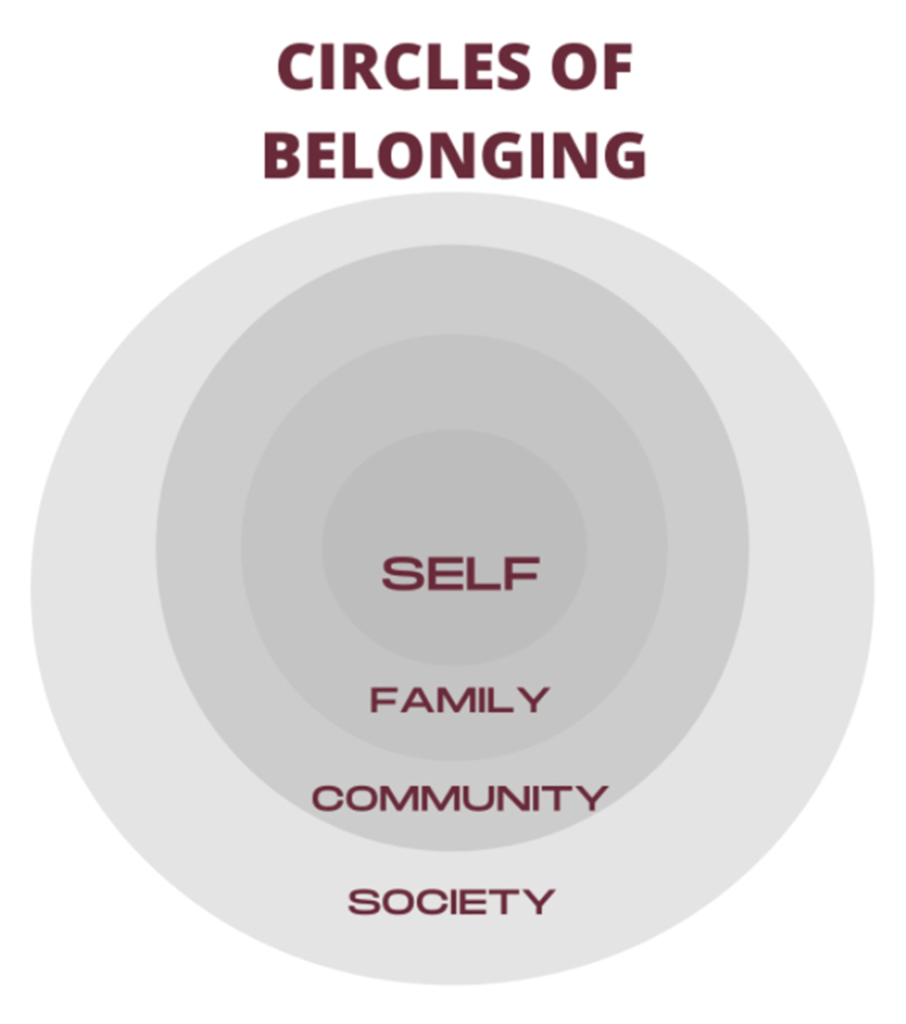
Kris—a pseudonym—is a white female in her 50s, a former consultant in the private sector, now an executive director in the non-profit industry, who I coach. Recently, she’s been focused on the challenge of creating a culture of belonging in her organization. To make that possible, I always focus first on what I call a Personal Belonging Plan. The premise is that in order to create a culture of belonging for others, we must first experience what belonging truly means to us individually.
In order to create a culture of belonging for others, we must first experience what belonging truly means to us individually. Click To TweetI started out by asking Kris to think of a group or community where she felt a sense of belonging, and to name one word that describes that feeling. She took a deep breath, closed her eyes, and before long she began to smile. When she opened her eyes, Kris told me that she’d thought about spending time with her family. The word that described her feeling of belonging in those times was “safe.”
Next, I asked Kris to look at the diagram below, and to think about the different levels of influence in her life—self, family, community, and society. I asked her to shade the diagram green in the circles where she felt a sense of belonging, and red where she didn’t.

To my surprise, Kris told me she felt a sense of belonging in every one of the four circles. “It sounds weird, but I don’t feel like belonging is something I have struggled with too much,” she said. She attributed this to being part of a close-knit family, and to the privileges she was afforded as a white woman.
Two weeks later, Kris and I revisited the topic. What had come up for her were a couple of survival mechanisms she had used to help her fit in and succeed in the predominantly male-led environments that were typical of the consulting cultures in which she had previously worked. These environments valued analytical thinkers and did not honor the same skill sets that Kris did, including emotional intelligence, relationship building, and valuing multiple perspectives. Her survival mechanisms included convincing herself that, “I don’t want to belong there anyway” and, “In order to belong, I will hide parts of myself.” We then revisited her personal belonging plan for a more honest assessment. There was a lot more red shading, at all levels, on the diagram this time.
Many of us have been swimming in the water of our organizational cultures for so long that we don’t even recognize how we’ve been compelled to suppress important parts of our identity. So, how do we liberate ourselves, given the confines of these power structures? How can we truly achieve belonging and acceptance of our whole self so that we can live more authentically as who we really are?
Many of us have been swimming in the water of our organizational cultures for so long that we don’t even recognize how we’ve been compelled to suppress important parts of our identity. Click To TweetOur approach is to create a belonging plan that engages the head first, then the heart, and finally the hands.
1.) Head.
The goal of focusing on Head first is simply to bring awareness to where we may or may not be experiencing belonging or acceptance. For Kris, shading in the diagram gave her an awareness not only of areas of her life where she could have a greater sense of belonging, but also how she’d learned to protect herself when she couldn’t change the culture around her.
2.) Heart.
We crave a sense of belonging as the fulfilment of our basic human need to be accepted. However, showing up more authentically in certain cultures can be scary. Oftentimes doing so requires us to go against accepted cultural norms, and to recognize that going against those norms may not always be welcomed. Ask yourself how comfortable you are going against the grain.
If the thought of going against cultural norms makes you panic, evaluate why. In some cases, it is because the environment you are in isn’t ready for a shift, and there could be real consequences. For example, in Kris’s case, being perceived as “too emotional” in her environment may have impeded her ability to get promoted. In some cases, fear is simply a natural response to uncertainty, because we would be introducing an unknown, a new norm, to our environment, and we aren’t sure how it will be received. In this case, we need to test out the temperature of the water—the willingness of our environment to accommodate change—before we plunge in. We can assure ourselves that it is ok by taking baby steps. I will talk about this more deeply in the next section.
If the thought of going against cultural norms makes you panic, evaluate why. In some cases, it is because the environment you are in isn’t ready for a shift, and there could be real consequences. Click To TweetThe goal in this phase is to listen to your Heart, and honor that it is natural to feel emotions such as panic, fear, or anxiety when thinking about how to shift norms.
3.) Hands.
Once you have decided where you want to work on showing up in ways that feel truer to yourself, think about baby steps you can take that will help you start moving toward your goals. Here are some examples of baby steps my clients have taken:
- Belonging to Self: Rose, an executive of a Fortune 100 company and mom of four, finds herself feeling “unseen” at home. “No matter what I do, it doesn’t seem like anyone in my family notices.” During her holiday break, she had time to reflect on “belonging to herself” and realized that she is not spending enough time doing the things that nourish her, such as spending time in nature, writing, and painting. She has committed to making sacrosanct space for these activities, on weekends and holidays. She notices that when she shares those experiences with her family, it helps them to see and appreciate her as the unique person she is.
- Community: John, an executive director at a nonprofit, realized that he didn’t have a feeling of belonging in the northeastern community in which he lives. After reflecting, he realized that everything he does outside of spending time with his family requires him to take on a leadership position (i.e., board chair or professor). He committed to making more time for activities in which he can just be a “part of the crowd,” including taking his family to musicals or to cheer on his favorite baseball team, the Boston Red Sox.
- Organization: Kris is now the CEO of a non-profit organization. Now that she has that positional power, she’s become aware of the ways she has hidden parts of herself to “fit in.” Her goal is to leverage the analytical parts of herself—the “head” that she’s brought to other organizations—but also the “heart” through personal relationships, team building, and putting more women into leadership roles.
- Society: A Black woman, mother, and CEO of a small and rapidly growing business, lives in a community that offers great education for her children and proximity to members of her family – but is not very diverse. Often, she and her children find themselves dealing with microaggressions such as going to a high-end clothing store and being questioned about whether they intend to buy something by store clerks who aren’t used to seeing Black people in the store as customers. One solution she came up with was to make space for travel with her family outside of her community, even outside the country, where she can experience a more diverse and inclusive culture and feel a sense of belonging at a societal level.
The overall goal of this process is not to feel pressured into turning every circle on the diagram green. It simply isn’t possible to feel a sense of belonging all of the time. The goal is to ensure that you are consciously choosing what’s right for you and staying curious about what’s possible. The path to belonging is just that: It is a path, and not a moment.
It isn’t possible to feel a sense of belonging all the time. The goal is to ensure that you are consciously choosing what’s right for you and staying curious about what’s possible. The path to belonging is a path, not a moment. Click To Tweet

















